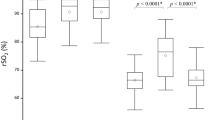Abstract
Recently, it is common to perform the Fontan procedure after the Glenn procedure as surgical repair for the univentricular heart. How the brain oxygen saturation (rSO2) values change with the cardiac restoration and the process of growth during these procedures in individual children remains unknown. In this study, we retrospectively studied rSO2 data as well as the perioperative clinical records of 30 children who underwent both Glenn and Fontan procedures by the same surgeon in the same institute. The rSO2 was measured at the beginning and end of each procedure with an INVOS 5100C. Cerebral perfusion pressure was calculated by subtracting central venous pressure from mean arterial pressure. Arterial oxygen saturation (SaO2) and the hemoglobin concentration were obtained as candidates affecting rSO2 changes at the start and the end of both procedures. The rSO2 increased during the Glenn procedure, but this increase was slight and insignificant. On the other hand, the rSO2 significantly increased during the Fontan procedure. Significant increases in SaO2 were observed only between the beginning and end of the Fontan procedure. Correlation coefficients determined by linear regression analysis were more than 0.5 between rSO2 and SaO2 in both procedures. Multiple linear regression analysis showed that SaO2 was the key determinant of the rSO2. The rSO2 increases step by step from the Glenn to the Fontan procedure in the same patient. Within each procedure, SaO2 is the key determinant of the rSO2. The significance of rSO2 monitoring in these procedures should be further evaluated.

Similar content being viewed by others
References
Andropoulos DB, Stayer SA, Diaz LK, Ramamoorthy C (2004) Neurological monitoring for congenital heart surgery. Anesth Analg 99:1365–1375
Morimoto Y, Niida Y, Hisano K, Hua Y, Kemmotsu O, Murashita T, Yasuda K (2003) Changes in cerebral oxygenation in children undergoing surgical repair of ventricular septal defects. Anaesthesia 58:77–83
Hirsch JC, Charpie JR, Ohye RG, Gurney JG (2009) Near-infrared spectroscopy: what we know and what we need to know—a systematic review of the congenital heart disease literature. J Thorac Cardiovasc Surg 137:154–159
Simons J, Sood ED, Derby CD, Pizarro C (2012) Predictive value of near-infrared spectroscopy on neurodevelopmental outcome after surgery for congenital heart disease in infancy. J Thorac Cardiovasc Surg 143:118–125
Szwast A, Tian Z, McCann M, Soffer D, Rychik J (2012) Comparative analysis of cerebrovascular resistance in fetuses with single-ventricle congenital heart disease. Ultrasound Obst Gyn 40:62–67
Williams IA, Fifer C, Jaeggi E, Levine JC, Michelfelder EC, Szwast AL (2013) The association of fetal cerebrovascular resistance with early neurodevelopment in single ventricle congenital heart disease. Am Heart J 165:544–550
Fenton KN, Lessman K, Glogowski K, Fogg S, Duncan KF (2007) Cerebral oxygen saturation does not normalize until after stage 2 single ventricle palliation. Ann Thorac Surg 83:1431–1436
Kussman BD, Wypij D, DiNardo JA, Newburger JW, Mayer JE Jr, del Nido PJ, Bacha EA, Pigula F, McGrath E, Laussen PC (2009) Cerebral oximetry during infant cardiac surgery: evaluation and relationship to early postoperative outcome. Anesth Analg 108:1122–1131
Pollard V, Prough DS, DeMelo AE, Deyo DJ, Uchida T, Widman R (1996) The influence of carbon dioxide and body position on near-infrared spectroscopic assessment of cerebral hemoglobin oxygen saturation. Anesth Analg 82:278–287
Menke J, Moller G (2014) Cerebral near-infrared spectroscopy correlates to vital parameters during cardiopulmonary bypass surgery in children. Pediatr Cardiol 35:155–163
Bertolizio G, DiNardo JA, Laussen PC, Polito A, Pigula FA, Zurakowski D, Kussman BD (2015) Evaluation of cerebral oxygenation and perfusion with conversion from an arterial-to-systemic shunt circulation to the bidirectional Glenn circulation in patients with univentricular cardiac abnormalities. J Cardiothorac Vasc Anesth 29:95–100
Ricci M, Lombardi P, Schultz S, Galindo A, Coscarella E, Vasquez A, Rosenkranz E (2006) Near-infrared spectroscopy to monitor cerebral oxygen saturation in single-ventricle physiology. J Cardiothorac Vasc Anesth 131:395–402
Dullenkopf A, Frey B, Baenziger O, Gerber A, Weiss M (2003) Measurement of cerebral oxygenation state in anaesthetized children using the INVOS 5100 cerebral oximeter. Paediatr Anaesth 13:384–391
Rhondali O, Juhel S, Mathews S, Cellier Q, Desgranges FP, Mahr A, De Queiroz M, Pouyau A, Rhzioual-Berrada K, Chassard D (2014) Impact of sevoflurane anesthesia on brain oxygenation in children younger than 2 years. Paediatr Anaesth 24:734–740
Fenton KN, Freeman K, Glogowski K, Fogg S, Duncan KF (2005) The significance of baseline cerebral oxygen saturation in children undergoing congenital heart surgery. Am J Surg 190:260–263
Kussman BD, Wypij D, Laussen PC, Soul JS, Bellinger DC, DiNardo JA, Robertson R, Pigula FA, Jonas RA, Newburger JW (2010) Relationship of intraoperative cerebral oxygen saturation to neurodevelopmental outcome and brain magnetic resonance imaging at 1 year of age in infants undergoing biventricular repair. Circulation 122:245–254
Author information
Authors and Affiliations
Corresponding author
Ethics declarations
Conflict of interest
All authors declare that we have no conflict of interest.
Ethical Approval
All procedures performed in studies involving human participants were in accordance with the ethical standards of the institutional research committee (015-0466) and with the 1964 Helsinki declaration and its later amendments or comparable ethical standards.
Informed Consent
According to our institutional policy, the informed consent is not required in case of retrospective study. Therefore, we did not obtain the individual informed consent. Instead, we open the information of this study through our institutional homepage according to our institutional rule.
Electronic supplementary material
Below is the link to the electronic supplementary material.
Rights and permissions
About this article
Cite this article
Yagi, Y., Yamamoto, M., Saito, H. et al. Changes of Cerebral Oxygenation in Sequential Glenn and Fontan Procedures in the Same Children. Pediatr Cardiol 38, 1215–1219 (2017). https://doi.org/10.1007/s00246-017-1647-0
Received:
Accepted:
Published:
Issue Date:
DOI: https://doi.org/10.1007/s00246-017-1647-0




